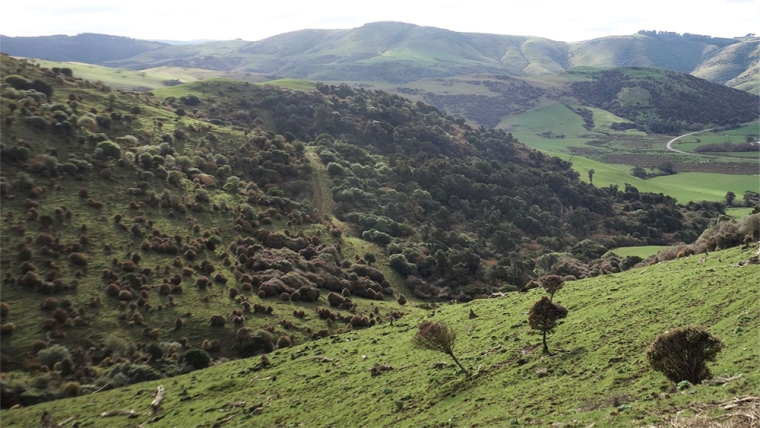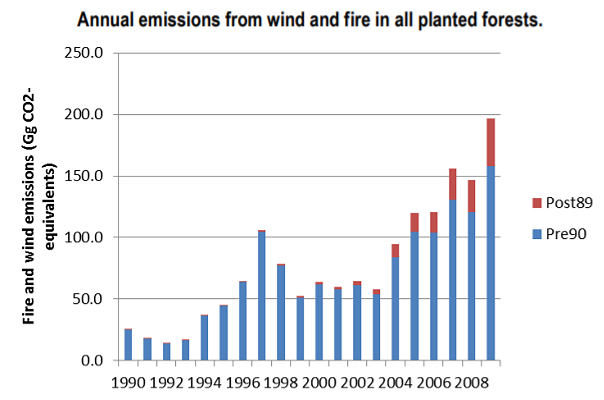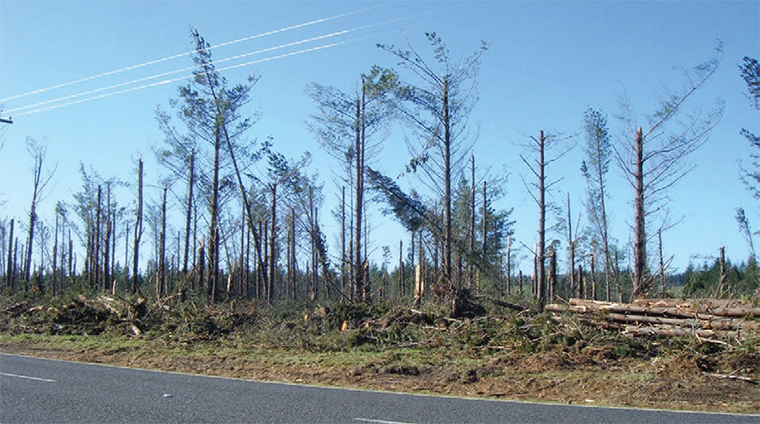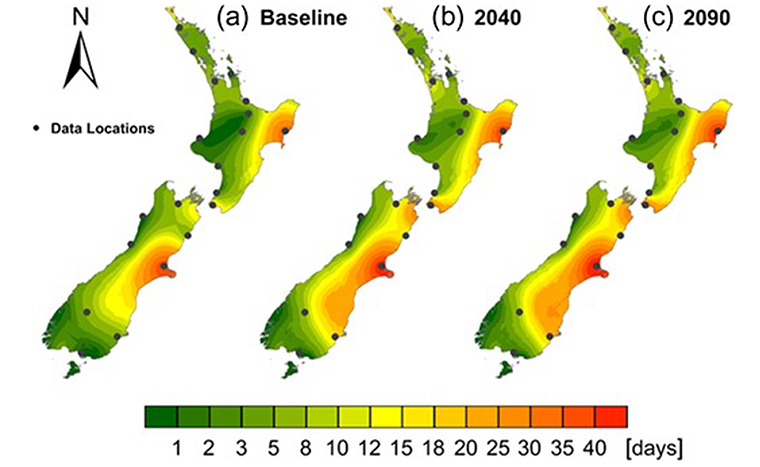
A recent inquiry over the impact of fire or other natural disturbances on a forestry block (of whatever type) that is registered to collect carbon credits from the ETS, prompted this article and coming on the heels of the latest IPCC report perhaps makes it a bit more relevant.
At the moment total emissions from “natural disturbance” in New Zealand forests over the latest calibration period I could find (1990–2009) is a relatively small fraction of the country’s total forest carbon budget (e.g. it represented about 5% of the annual net removals by planted forests; MfE 2012) when compared with other countries such as Canada, where natural disturbances are responsible for up to 30% of the country’s total emissions.

Source: MPI 2014
Over the period recorded wind was the major cause of losses with fire relative minor. Those around Canterbury in 2013 will also remember the huge losses which resulted in an estimated 4,000ha of forest flattened, and greater damage occurring back in 1975.

Source:NZFFA
Since the mid-1960’s approximately 70,000ha’s of forest has been destroyed, but then New Zealand is a windy country. However, in recent times, the perception at least is that fire is over taking wind as the major culprit of destroying forest. The area of forest burning each year in New Zealand is going up. It has doubled since recent records began, from about 300 hectares a year since 1988 to over 600 hectares by 2015. While some of this area is native forest, the majority is exotic plantation. Last year an estimate is that over 2,000ha’s was burnt. In the meantime, outside of New Zealand the reporting of wildfires has become a daily event with the areas over all continents being measured in thousands of kilometres not hectares.
In the background we are still hearing stories about productive farmland being converted to forestry.
It begs the question have these forestry investors done their homework around future risks of being able to achieve the returns they expect? Below is a map of the expected increases in projections of annual frequency of Very High and Extreme (VH + E) forest fire danger over fire season months (Oct–Apr).

Source: Forestry: An International Journal of Forest Research, Volume 92, Issue 1, January 2019,
When averaged over all sites, the number of days with VH + E fire risk is projected to increase by 71 per cent by 2040, and by a further 12 per cent by 2090. Of course, wind, disease and insect damage are also predicted to increase with the onset of climate change.
Forest established from now on are likely to be using the updated ETS system for forestry which allows them to adopt averaging accounting as laid out by MPI. Under this system foresters using averaging accounting won’t have to pay back NZUs after adverse events. (Fire, wind, volcanic events and Alpine fault like earthquakes to name some). This means no requirement to pay back emissions units for carbon storage lost after a significant adverse event, if the affected area is re-established within four years. This non-liable aspect must make the perceived risk appear less. At least on the surface.
Unfortunately, the law also has a non-double dipping clause which means no additional carbon credits can be earnt until the forest is back up to the stage at which it was destroyed. This could be another 15 -30 years as younger forests tend to be a bit safer. So, the forest owner not only has the cost of replanting and delayed harvest dates to contend with but also no carbon credits, which presumably have been a major part of the motivation for planting the forest in the first place. Insurance could be seen as an obvious ‘first defence’ against financial losses and a forestry online put the following example of what some of the potential losses are.
Like what you read? Support our journalists. Find out how.
Marlborough Fire December 2015
Estimated 1250ha burnt over 14days. Cause determined as a hot chainsaw left unattended. Estimated $2M in fire suppression costs. At the time, likely New Zealand’s largest commercial plantation fire at an estimated $14,000,000 claim value. If the forest was covered then any insurance company is not going to willingly dig into their pockets.
It is likely most forests are not fully covered also, given the full cost of insurance.
Something else to consider; if the landowner is aiming to establish a ‘permanent forest’ there will come a time when the forest stops sequestering carbon. This is the case whether the plan is to harvest it or to leave it alone as a ‘Permanent Forest Sink Initiative Forest’. So, the credits will eventually stop coming. But the liabilities will likely go on forever. At the very least the forest owner may need to maintain those insurance payments in perpetuity, and regularly pay for someone to check that your carbon still exists and register that fact with MPI.
For sheep and beef farmers (this may also apply to deer and some dairy) there are other ways in which they are able to mitigate the risk. Most hill farms have areas of lesser use for livestock production. These could be put into ‘pockets’ of forestry of smaller areas. This should mean that risk from fire and wind are reduced are there are effective ‘firebreaks’ and changes in ‘aspect’ which offer some protection.
Smaller plantations do often mean that costs of establishment and harvesting are higher but there are ways to work this to the landowner’s advantage. This can be by selective logging where the best logs are extracted first over time and allowing the lesser trees to obtain their optimal value and a later date. Finishing farmers should be very familiar with the concept where smaller numbers of prime lambs and cattle are drafted off at regular intervals allowing lesser animals more time to come up to weight and value. John and Rosalie Wardle have been practicing this concept for decades now to their advantage. The video link is worth a look to those unfamiliar with either them or the concept. Selective logging should also reduce the incidence of damage created by slash (waste trimmings) washed into waterways in floods etc.
Log Prices
Select chart tabs
22 Comments
They could also plant a buffer zone of low flammability natives, though i am not sure how many on this list meet the 5 metre height requirement.
https://www.scionresearch.com/__data/assets/pdf_file/0015/64140/31328-F…
Gorse , pampas, manuka etc have high flammability, and many of these low production areas would be covered in it , so actual increase in fire risk would be mitigated by comparing to these to some degree vs pasture.
That's right scrub is just as much at risk of fire and some may argue more so if there is gorse and long grass. I personally think wind is the biggest threat to production forest. In permanent forest the risk of both decreases over time as the canopy opens and bigger trees start to collapse creating light wells for ferns etc to start dominating. In drier areas the fire risk in permanent forest will be higher for much longer and I feel these areas are more suited to production forest with regular rotations. Either way incorporating forest into a farming system is the best option.
115 year old radiata in Otago - 2021
1922 - 1,300 trees per ha, 444 tonnes per ha of wood
2006 - 199 trees per ha, 1,816 tones per ha of wood
2021 - 188 trees per ha, 1,988 tonnes per ha of wood
Full of natives now plus a lot of carbon locked away
Still growing!! - not sure when it will stop
100 year old radiata in Kaingaroa - remember that place?
Last stand left still growing - now at around 1,300 tonne per ha - full of natives beneath - cost = zero
Still growing as well!!!
Averaging - you get carbon for the first @16 years - then none. If you lose the forest after that you just have to replant into forest - as you wont get any more carbon anyway.
Insurance does exist.
Anyway while everyone moans away Im busy with all the farmers, who didn't have time to drive tractors around a few weeks ago, planting up 100 to 500ha + on their farms - sick of making no money farming hill country. Have a dairy/beef farmer going to sell off the flats and plant 600ha - sick of slaving away for nothing. Huge list of farmers buying up other farms to plant as well - they see the light. You would be very surprised who is planting and buying the land - I would say farmers planting their own land and buying more would make up well over 50% of all the new tree planting in NZ - the B and L report backs that up - there own levy payers have moved onto profitable things.
Only about @5,500 ha per year going to permanent forest based upon the report- hardly a takeover.
There is risk in anything you do - Drought - Why would you farm in a lot of areas with the increasing risk of that - the biggest risk is carrying on doing what you are doing if you are making no profit.
Yes I have been studying longevity in pine and have seen many old ones that are still very healthy. In the right spot I feel it could take 200yrs for the forest dynamics to change to native and even then there will still be a component of pine. But so what a tree is a tree and there is no other way to transform grassland to forest in such a short and efficient way. I have read that some baltic pine has been found growing at 500yrs of age and I would not be surprised if some radiata were capable of the same.
Interesting article. Thanks Guy.
There's quite a few pests that if they got in would be a nightmare for forestry.
https://www.mpi.govt.nz/biosecurity/pests-and-diseases-we-want-to-keep-…
Some would be very hard to eradicate once in.
Foot and Mouth, M Bovis etc etc
Sure. I wasnt suggesting forestry was any more risky than other sorts of farming.
Also, can you clarify what youe numbers refer to in your previous comment. It sounds interesting but I'm confused about what you're referring to in some bits. Ta.
The age numbers show that pine will continue to grow well up to 100 years plus - there is a 150 year old radiata in Wellington’s botanic garden. It shows you can lose trees to fire and wind but the area is small and these trees will continue to grow and store carbon for over a century. If you believe it is vital to capture and store carbon, both future and past emissions te cheapest option we have is trees. Native is great but is very very slow. If we need to make big change quickly fast growing trees like radiata will do the job. Risk yes as with anything. How serious do we believe the problem is? Do we need to act fast or can we wait 100 years? Calls to plant only native and not exotic shows in reality you believe we have a century or so to do it. Reading the IPCC report I didn’t see that quite the opposite.
Thanks. What's with the change in tree densities over time?
Agreed we need to get trees sucking up carbon ASAP. Engineered CCS schemes sound like pie in the sky to me. Needs too much energy.
I wonder if we should also be planting more urban trees too, not just for the carbon but also for the cooling and psychological benefits too.
The trees thin themselves out naturally over time. This then let’s in more light and understory shrubs appear. Over a long time higher trees species can appear. All trees help with shade, shelter and biodiversity and all helps. Trees help but we need also to reduce emissions, this is the most important thing to do. Trees just buy some time to make the real changes.
Carbon foresters ( should) have a duty of care to their neighbours. I believe that any forest over a given area eg. 200 hectares should be required to maintain a grazed firebreak of not less than 500 metres width on all boundaries
Maybe there should be a 500m riparian zone on each side of a waterway with no grazing.
That would then become a fire hazard.
I was only being tongue in cheek. As a farmer and forester I was looking at the lost productivity.
Why?
Better tell all my farmer clients who are planting as they are doing over 50% of all the planting. I have a pretty good idea what they would say.
How many are planting in excess of 200 hectares?
Lots we have a 3 year waiting list, all farmers, we plant 2,500ha new a year. They are sick of being poor or are the top ones and know how to make money and setup a future for their families. Many others are also planting with other companies.
200 hectares was a suggested threshhold. My point is that a properly constructed forest allows for the possibility of fire and makes provision for fire breaks. And the best way to maintain those breaks free of combustible material is to graze them. In theory a naturally occurring fire - lightning- would then be confined to the area where it started. It seems that a lot of recent farm to forestry conversions are in parts of the NI that are susceptible to high temperatures and high winds. Without provision for mandatory fire breaks there is a distinct possibility that a whole district could go up in flames, especially if the forecast extremes of weather conditions eventuate.
Firebreaks don’t work. Fire can jump km. Fire loss is not that bad. Wind is worse but mainly on plains - Canterbury, CNI. Broken hill country tends to have less loss. In reality drought is a bigger risk to farming. Flooding - trees hold the soil while bare grass washes away. Just look at the erosion in east coast on NI. The reality is farming on this hill country doesn’t make true profit. I’m not bagging farmers as most of my friends and clients are farmers. They are desperate to make profit as they realise they can’t sustain or pass land on if they dont. It’s a reality I’m afraid that many just can’t accept. No profit no future and that’s why they are changing.
JL I'm not bagging foresters either. What I am saying is that a bit of foresight and planning at the start is better than a disaster at the other end. I know that fire can jump breaks, but surely that depends on the width of the breaks. As you rightly point out, trees hold the land during extreme rainfall events, and a lot of our hill country should never have been cleared. But the main tool used for clearance was fire, which once it got going did not discriminate. On certain classes of country blanket afforestation can in its own way be potentially as harmful as blanket livestock grazing. In each case the main driver in the past has been the perceived profitability at the time of commencement.
The reality is firebreaks make people feel good and help for access. If you have strong winds the embers just get picked up and travel huge distances. Its taking opportunities with weather, humidity and natural feature to control them. Sometimes its simply watch and hope - large fires are the most terrifying things you can imagine and its not until you are near one you realise the power of nature and futility of people.
I don't disagree with afforestation either - planting needs to recognize environmental constraints - this is done a lot more based upon soil types, erosion and waterways now. What is planted now is mush more selective and the areas not planted are far larger than even 10 years ago. This is part of the angst - you don't want to plant forests on hard, steep eroding land - you want to be on gentle, easy access as regulation, rightly so, has stopped land being used as its not environmentally sound. In effect a greater number of people are chasing a small area of land suitable as farms are being chased of this harder land as well and dairy pushing in at the top end - well it was.
The IPCC predicts more rain in summer on the east coasts (but less in winter and spring). Maybe that will have some mitigating effect on the frequency and intensity of forest fires?
https://www.ipcc.ch/report/ar6/wg1/downloads/factsheets/IPCC_AR6_WGI_Re…
Although it does also say this "The intensity, frequency and duration of fire weather events are projected to increase throughout Australia (high confidence) and New Zealand (medium confidence)"

We welcome your comments below. If you are not already registered, please register to comment
Remember we welcome robust, respectful and insightful debate. We don't welcome abusive or defamatory comments and will de-register those repeatedly making such comments. Our current comment policy is here.